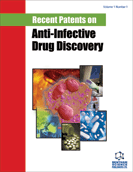[1]
Brown SK, Shalita AR. Acne vulgaris. Lancet 1998; 351: 1871-6.
[2]
Chandrashekhar BS, Anitha M, Ruparelia M, Vaidya P, Aamir R, Shah S, et al. Tretinoin nanogel 0.025% versus conventional gel 0.025% in patients with Acne vulgaris: A randomized, active controlled, multicentre, parallel group, phase IV clinical trial. J Clin Diagn Res 2015; 9(1): WC04-9.
[3]
Quan M, Strick RA. Management of Acne vulgaris. Am Fam Physician 1988; 38: 207-18.
[4]
Koo J. The psychosocial impact of acne: Patients’ perceptions. J Am Acad Dermatol 1995; 32: S26-30.
[5]
Rathi SK. Acne vulgaris treatment: The current scenario. Indian J Dermatol 2011; 56(1): 7-13.
[7]
Marchese A, Orhan IE, Daglia M, Barbieri R, Di Lorenzo A, Nabavi SF, et al. Antibacterial and antifungal activities of thymol: A brief review of the literature. Food Chem 2016; 210: 402-14.
[8]
Raman A, Weir U, Bloomfield SF. Antimicrobial effects of tea-tree oil and its major components on Staphylococcus aureus, Staph. epidermidis and Propionibacterium acnes. Lett Appl Microbiol 1995; 21(4): 242-5.
[9]
Koh KJ, Pearce AL, Marshman G, Finlay-Jones JJ, Hart PH. Tea tree oil reduces histamine-induced skin inflammation. Br J Dermatol 2002; 147(6): 1212-7.
[10]
Ajazuddin Alexander A. Khichariya A, Gupta S, Patel RJ, Giri TK, et al Recent expansions in an emergent novel drug delivery technology: Emulgel. J Control Release 2013; 171(2): 122-32.
[11]
Eid AM, El-Enshasy HA, Aziz R, Elmarzugi NA. Preparation, characterization and anti-inflammatory activity of Swietenia macrophylla nanoemulgel. J Nanomed Nanotechnol 2014; 5: 190.
[12]
Ahmad J, Kohli K, Mir SR, and Amin S. Self-emulsifying nano carriers for improved oral bioavailability of lipophilic drugs. Rev Adv Sci Eng 2012; 1(2): 134-47.
[13]
Taglietti M, Hawkins CN, Rao J. Novel topical drug delivery systems and their potential use in Acne vulgaris. Skin Therapy Lett 2008; 13: 6-8.
[14]
Yilmaz E, Borchert HH. Effect of lipid-containing, positively charged nanoemulsions on skin hydration, elasticity and erythema--an in vivo study. Int J Pharm 2006; 307(2): 232-8.
[15]
Gannu R, Palem CR, Yamsani VV, Yamsani SK, Yamsani MR. Enhanced bioavailability of lacidipine via microemulsion based transdermal gels: Formulation optimization, ex vivo and in vivo characterization. Int J Pharm 2010; 388: 231-41.
[16]
Vromen J. Formulations for topical delivery of bioactive
substances and methods for their use. US7241456B2 (2007).
[17]
Anderson RR. Topical aminolevulinic acid-photodynamic
therapy for the treatment of Acne vulgaris. US6897238B2 (2005).
[18]
Niemiec SM, Wang JC, Wisniewski SJ, Stenn KS, Lu GW. Topical delivery systems for active agents. US 6284234B1 (2001).
[19]
Chaudhry M, Naithani V. Topical herbal formulation for
treatment of acne and skin disorders. US8268367B2 (2008).
[20]
Filippova IV, Filippov KL. Dermatological cream with
natural ingredients base. US8613961B1 (2013).
[21]
Ahmad J, Kohli K, Mir SR, Amin S. Formulation of self-nanoemulsifying drug delivery system for telmisartan with improved dissolution and oral bioavailability. J Dispers Sci Technol 2011; 32: 958-68.
[22]
Ahmad J, Mir SR, Kohli K, Amin S. Quality by design approach for self nanoemulsifying system of paclitaxel. Sci Adv Mater 2014; 6: 1778-91.
[23]
Ahmad J, Mir SR, Kohli K, Amin S. Effect of oil and co-surfactant on the formation of Solutol HS 15 based colloidal drug carrier by Box–Behnken statistical design. Colloids Surf a Physicochem Eng Asp 2014; 453: 68-77.
[24]
Ahmad J, Mir SR, Kohli K, Chuttani K, Mishra AK, Panda AK, et al. Solid-nanoemulsion preconcentrate for oral delivery of paclitaxel: formulation design, biodistribution, and γ-scintigraphy imaging. BioMed Res Int 2014; 2014984756
[25]
Eshun K, He Q. Aloe vera: A valuable ingredient for the food, pharmaceutical and cosmetic industries--a review. Crit Rev Food Sci Nutr 2004; 44(2): 91-6.
[26]
De Paula IC, Ortega GG, Bassani VL, Petrovick PR. Development of ointment formulations prepared with Achyrocline satureioides spray-dried extracts. Drug Dev Ind Pharm 1998; 24(3): 235-41.
[27]
Barkat MA, Ahmad J. Harshita, Ali R, Rahman MA, Kaleem S, Singh SP, Ahmad FJ. Formulation design of micronized silver sulfadiazine containing aloe vera gel for wound healing. Curr Bioact Compd 2016; 12(2): 63-8.
[28]
Islam MT, Rodriguez-Hornedo N, Ciotti S, Ackermann C. Rheological characterization of topical carbomer gels neutralized to different pH. Pharm Res 2004; 21(7): 1192-9.
[29]
Amin S, Sarfenejad A, Ahmad J, Kohli K, Mir SR. Nanovesicular transfersomes for enhanced systemic delivery of telmisartan. Adv Sci Eng Med 2013; 5(4): 299-308.
[30]
Nava G, Pinon E, Mendoza L, Mendoza N, Quintanar D, Ganem A. Formulation and in vitro, ex vivo and in vivo evaluation of elastic liposomes for transdermal delivery of ketorolac tromethamine. Pharmaceutics 2011; 3(4): 954-70.
 24
24 5
5





















